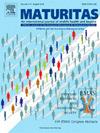月经紊乱和哮喘风险:一项针对20岁出头至40岁左右女性的前瞻性研究
IF 3.6
2区 医学
Q2 GERIATRICS & GERONTOLOGY
引用次数: 0
摘要
目的探讨40多岁女性在生育年龄经历月经紊乱是否与当前哮喘有关。方法数据来自澳大利亚妇女健康纵向研究的1240名参与者(1973年至1978年出生)。在1996年和2000年至2018年每三年收集一次月经紊乱的信息。当前哮喘被定义为(1)曾经有医生诊断的哮喘,(2)在过去12个月内经历哮喘发作,和/或使用哮喘药物。使用广义估计方程的逻辑回归将当前哮喘与月经紊乱的重复测量联系起来,调整社会人口统计学特征、健康行为、生殖因素、早产和月经初潮前哮喘。结果在参与者中,14.2%的人在40多岁时患有哮喘。在调整协变量后,在生育年龄报告大量月经出血(OR: 1.62[1.10至2.39])、严重经期疼痛(OR: 1.67[1.10, 2.55])或经前综合征(OR: 1.66[1.20至2.31])与当前哮喘的较高几率相关。经期不规律的报告与调查时间之间存在相互作用,在后来的调查中,经期不规律与当前哮喘的关系越来越密切。结论:在20多岁到40多岁期间经历过大量月经出血、严重痛经和经前综合症的女性在40多岁时患哮喘的几率更高。相比之下,只有在40多岁时才发现月经不规律与哮喘有关。这些结果表明,女性在生育年龄的月经特征可能反映了她们在中年时的肺部健康状况。本文章由计算机程序翻译,如有差异,请以英文原文为准。
Menstrual disorders and the risk of asthma: A prospective study of women from their early twenties to their mid-forties
Aim
To examine whether experiencing menstrual disorders during reproductive years is associated with current asthma among women in their 40s.
Methods
Data were from 1240 participants (born between 1973 and 1978) in the Australian Longitudinal Study on Women's Health. Information on menstrual disorders was collected in 1996 and every three years from 2000 to 2018. Current asthma was defined as (1) ever having doctor-diagnosed asthma, and (2) experiencing an asthma attack, and/or using asthma medication in the last 12 months. Logistic regression with generalised estimating equations was used to link current asthma to repeated measures of menstrual disorders, adjusting for socio-demographic characteristics, health behaviours, reproductive factors, preterm birth, and asthma before menarche.
Results
Among the participants, 14.2 % had current asthma in their 40s. After adjusting for covariates, report of heavy menstrual bleeding (OR: 1.62 [1.10 to 2.39]), severe period pain (OR: 1.67 [1.10, 2.55]), or premenstrual syndrome (OR: 1.66 [1.20 to 2.31]) across reproductive years was associated with higher odds of current asthma. There was an interaction between report of irregular periods and survey time, with irregular periods being increasingly associated with current asthma in later surveys.
Conclusions
Women who experienced heavy menstrual bleeding, severe period pain, and premenstrual syndrome at any point from their 20s to 40s had higher odds of current asthma in their 40s. In contrast, irregular periods were associated with current asthma only when reported during their 40s. These results suggest that women's menstrual characteristics in their reproductive years may reflect their lung health in middle age.
求助全文
通过发布文献求助,成功后即可免费获取论文全文。
去求助
来源期刊

Maturitas
医学-妇产科学
CiteScore
9.10
自引率
2.00%
发文量
142
审稿时长
40 days
期刊介绍:
Maturitas is an international multidisciplinary peer reviewed scientific journal of midlife health and beyond publishing original research, reviews, consensus statements and guidelines, and mini-reviews. The journal provides a forum for all aspects of postreproductive health in both genders ranging from basic science to health and social care.
Topic areas include:• Aging• Alternative and Complementary medicines• Arthritis and Bone Health• Cancer• Cardiovascular Health• Cognitive and Physical Functioning• Epidemiology, health and social care• Gynecology/ Reproductive Endocrinology• Nutrition/ Obesity Diabetes/ Metabolic Syndrome• Menopause, Ovarian Aging• Mental Health• Pharmacology• Sexuality• Quality of Life
 求助内容:
求助内容: 应助结果提醒方式:
应助结果提醒方式:


